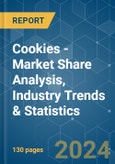The Cookies Market size is estimated at USD 12.14 billion in 2024, and is expected to reach USD 18.77 billion by 2029, growing at a CAGR of 9.10% during the forecast period (2024-2029).
This product will be delivered within 2 business days.
Key Highlights
- Bakers are developing innovative bakery products fortified with functional, low-fat, and sugar-free ingredients to reach a wider consumer base. Other factors, such as increasing consumer spending power and an increase in home bakers turning out freshly baked, healthy batches of cookies, are expected to drive the industry toward growth.
- Due to the growing concerns regarding obesity, poor diet, and other health issues, an increasing number of consumers are shifting toward better alternatives when it comes to food consumption, which is driving the expansion of the healthy cookies market. Moreover, consumers are finally developing a sense of healthy living, leading them to progressively opt for food associated with functional attributes.
- A key factor linked with the high consumption of cookies is rapid urbanization. With strategic marketing methods employed to entice new customers, the cookies market stands to benefit greatly. Additionally, the demand for freshly hand-made cookies has also surged among consumers as the consumers are more aware of the ingredients used in the products, which also influences the shift toward fresh bakery products. The main reason for the increase in consumption of these fresh and unprocessed products is the increasing awareness of the transparency of ingredients used in these products. This market trend is expected to boost product sales in the region.
- On the other hand, the manufacturing of cookies requires high input costs, which ultimately results in the high cost of the end product. While high-priced cookies are still popular within the developed markets, the same cannot be said for underdeveloped nations where high cost is a sensitive issue. This is anticipated to restrict the growth of the cookies market.
Cookies Market Trends
Increasing Demand for Healthy Cookies
- Customers across the world are increasingly becoming health conscious and are shifting towards gluten-free cookies owing to the rise in the number of chronic diseases. The key players are also focusing on launching healthier oatmeal raisin cookies and snickerdoodles with natural flavors, which is one of the major factors driving the growth of the cookies market.
- For instance, in February 2022, The No Nasties Project, based in Melbourne, launched a biscuit range rated 3.5 health stars, Better Cookies. There are three flavors in this range: Hazelnut Flavoured Choc Chip Minis, Choc Chip Minis, and Caramel Flavoured Minis. Aside from their natural flavors and colors, they are free from artificial ingredients.
- Additionally, oatmeal cookies are a healthier alternative to chocolate cookies and chocolate chip cookies. This is especially relevant for health-conscious consumers who attach a high level of importance to products that suit their active lifestyle. The increasing popularity of clean-labeled cookies is expected to change the market dynamics as more bakeries are working on certification from the Non-GMO Project. Furthermore, along with natural ingredients, consumers also demand a variety of options, such as limited-time deals, experiences, fun flavor combinations, and co-branding that puts a nostalgic or exciting take on old favorites. This, in turn, is boosting the cookie market growth globally.
Europe Dominate the Market
- The market is dominated by Europe, followed by North America. Countries like Italy and Spain lead the market demand for cookies in Western Europe. According to the Ministry of Agriculture, Food, and Environment (Spain), in 2021, the per capita consumption of pastries, cookies, and cereals was 13.79 kg, an increase from 13.4 kg in 2019.
- Moreover, rising concerns over glutamic disorders and lactose intolerance in developed countries of the European region are boosting the demand for gluten-free cookies and dairy-free cookies. According to Celiac Disease Foundation, in 2022, approximately 1 in 100 people in the United Kingdom will be affected by Celiac disease, and the number is continuously increasing.
- Additionally, the rising income of the people present in the region is an important factor behind the rising demand for premium cookies. It has been observed that the younger population is more inclined toward purchasing cookies. Cookies also make a good gifting option, along with chocolates. All these factors are anticipated to drive the growth of the cookies market in the region.
Cookies Industry Overview
Major companies in the cookies market are relying on flavor, format, and packaging innovation to maintain their competitive position regionally. Market leaders like Mondelēz International, Inc., have continued their investment in brand creation and product innovations to keep up the brand loyalties. In each region, the market is characterized by several local players and very few large players. With new product innovations, launches, and expansions in the market, key players are trying to gain a competitive advantage over the other players. Some of the major global key players in the cookies market include Britannia Industries Ltd, Campbell Soup Company, General Mills, Inc., Mondelēz International, Ferrero International S.A., Mckee Foods Corporation, and PepsiCo Inc., among others.Additional Benefits:
- The market estimate (ME) sheet in Excel format
- 3 months of analyst support
This product will be delivered within 2 business days.
Table of Contents
1 INTRODUCTION
4 MARKET DYNAMICS
5 MARKET SEGMENTATION
6 COMPETITIVE LANDSCAPE
Companies Mentioned (Partial List)
A selection of companies mentioned in this report includes, but is not limited to:
- Mondelēz International, Inc.
- General Mills, Inc.
- Campbell Soup Company
- Ferrero International S.A.
- Mckee Foods Corporation
- Grupo Bimbo, S.A.B. de C.V.
- PepsiCo Inc.
- Britannia Industries Ltd
- Parle Products Private Limited
- Barilla Holding S.p.A.
Methodology

LOADING...










